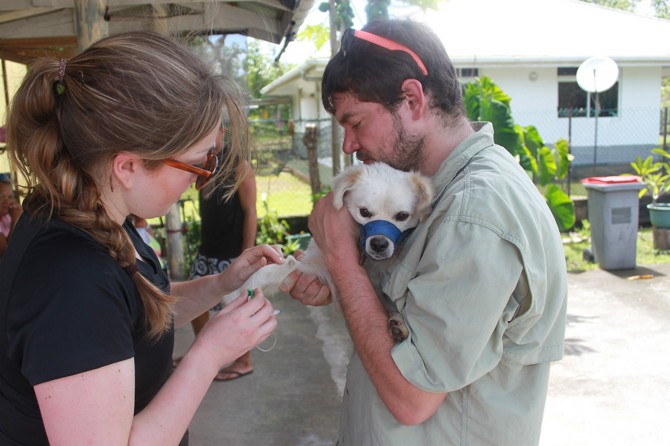Central Asian village dogs closest to original dogs
By Krishna Ramanujan
Village dogs – medium-sized dogs with pointy snouts that freely breed and live near people around the world – from present-day Nepal and Mongolia are direct descendants of the first domesticated dogs, which originated at least 15,000 years ago in the same region.
The findings from a Cornell-led international team, published online Oct. 19 in the Proceedings of the National Academy of Sciences, came from genetic analyses of 5,392 dogs, including 549 samples from village dogs collected over the last seven years by the paper’s authors.
The researchers used a comparison between the genomes of purebred dogs and village dogs to confirm that the animals were first domesticated from Eurasian gray wolves in Central Asia. Knowing precisely where domestication occurred has remained elusive.
“There are about a billion dogs in the world, and geneticists have mostly studied purebred dogs. But most of the world’s dogs are what we would call village dogs, and there has been little research done about these dogs,” said Adam Boyko, assistant professor of biomedical sciences at Cornell’s College of Veterinary Medicine and the paper’s senior author. Laura Shannon, a postdoctoral researcher in Boyko’s lab, is the paper’s first author.
The researchers conducted a large-scale survey of the genetic diversity found in village dogs from 38 countries and purebred dogs from 161 breeds. Most modern breeds are less than 200 years old, and the study showed that these dogs have little genetic diversity as breeding recently has narrowed their gene pools – a “bottleneck” that drastically reduces the size of a population and the variety of genes available for future generations. Genetic analyses show signatures of such bottlenecks and convey some of the history of a breed. The study showed that most breeds came from European dogs.
On the other hand, village dogs found in Central Asia show the most genetic diversity and lack genetic mixing with European dogs or breeds. Dogs in nearby regions, such as East Asia, India and Southwest Asia, also contain high levels of genetic diversity, with very little mixing with European dogs and breeds.
“We see a clear center of diversity around Central Asia,” with decreasing diversity the farther away the dogs moved from that center, Boyko said.
Village dog populations in the Neotropics and the South Pacific are almost completely derived from European stock, with some of these dogs having a mix of indigenous and European dogs. African village dogs reveal varying degrees of European and indigenous ancestry.
“The first dogs that were domesticated were never bred,” said Boyko. “By looking at patterns of genetic variation and then looking at their history, we found that village dogs from Central Asia are [descended] from original domesticated dogs.”
In future work, the researchers plan to get more samples from Central Asian village dogs to conduct finer-scale genetic analyses, to understand what traits were selected for as a result of domestication, and look for such adaptations as disease resistance.
“What were the pressures that led a wild population of dogs to hitch their futures to us?” Boyko said. “Dogs were the first animal to become domesticated with regard to humans.”
Funding for this project came from the National Science Foundation, National Geographic Society, Zoetis Animal Health and the Cornell University Center for Advanced Technology. Additional support came from the Cornell College of Veterinary Medicine Biobank, the Cornell Genomics Core Facility, and from crowd-sourced funding through PetriDish.org, which is now defunct.
Media Contact
Get Cornell news delivered right to your inbox.
Subscribe